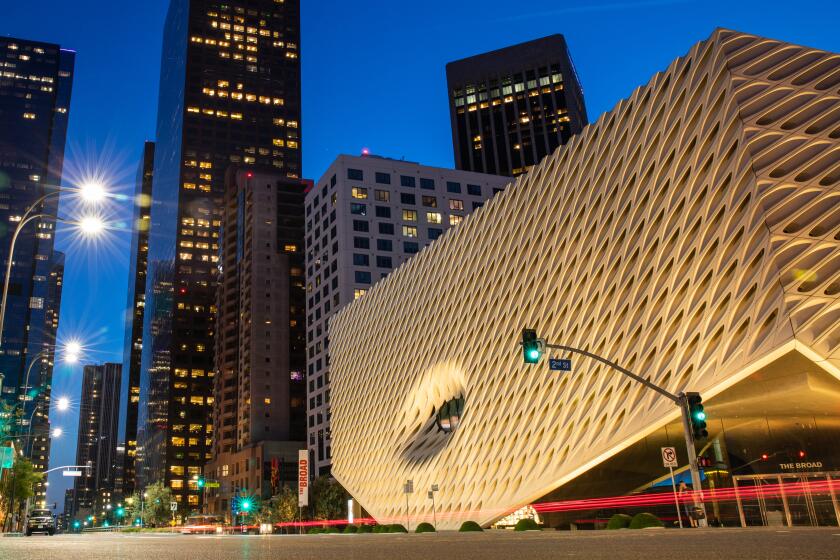In So Many Words
- Share via
Above a mini mall at Jefferson Boulevard and the 405, a billboard says, simply: “A Study In Air Color, 2001. Nitrogen, oxygen, particulate matter and light. On loan from the Museum of Contemporary Art, Los Angeles.”
Is MOCA expanding its gallery space? Not exactly. The billboards are a new MOCA ad campaign created by TBWA/Chiat/Day Los Angeles that turns the urban landscape into a work of art.
The $1-million campaign, 5% of MOCA’s annual budget and its most expensive campaign to date, debuted this week with unusual black-type-on-white-background billboards around the city and ads on the outside of buses that mimic the labels that traditionally identify art in a museum. Each site-specific ad plays off a variety of landmarks, including the Hollywood United Methodist Church, best known for its red AIDS ribbon, as well as more mundane spots like the intersection of Santa Monica Boulevard and Butler Avenue. Ads will also appear on radio and television, as well as on coffee cup sleeves (“Brown Rings on Table, 2001. Coffee, cup, table”), dry cleaning hangers (“Ugly Stepchild of the Wooden Hanger, 2000. Triangle wire, hook, paper”) and gas pump handles (“Middle East Dependency, 2001. Petroleum, pump, hose, steel casings”).
“We wanted to develop a campaign that captured the spirit of the museum,” says MOCA’s director, Jeremy Strick, who chose Chiat/Day’s campaign from several agencies that submitted bids. “We’re about doing things that are challenging and unexpected and haven’t been done before. That’s the nature of contemporary art. So we put it to the agency: What can you do to match that and present it to a broad audience, and even expand the boundaries of advertising?”
Although MOCA didn’t give Chiat/Day specific guidelines, no one wanted a cheap-shot campaign that ridiculed contemporary art. Instead, the campaign is intended to reflect how “contemporary art allows us to experience the world around us in new and exciting and challenging ways,” Strick says. “This campaign will make people think about their experience, about contemporary art, and about MOCA as a place. Contemporary artists are so often concerned with erasing the boundaries between art and life, and this campaign seemed a way to suggest that.”
The museum also wanted to attract potential new members, specifically the often-targeted 25- to 34-year-olds, a demographic that comes with its own challenges. While they may be trend savvy, they’re also over-saturated with information. Many know nothing about the museum or its downtown location.
“We had to create a campaign that involved people rather than speaking at them,” says Moe Verbrugge, a Chiat/Day art director who co-created the interactive campaign with Maya Rao. “Basically, we tried to look at the environment around us, which is what a lot of artists do for inspiration.”
Verbrugge, already a MOCA member, tried to solve “the problem here in L.A. that people really long for culture, and they don’t think it’s here.”
*
The ads take different tones, from slyly humorous to intentionally controversial. A billboard in Robertson’s high-fashion district reads: “People in Designer Labels Buying More Designer Labels, 2001. Cashmere, silk, cotton, wool leather.” One near the tony SportsClub L.A. on Sepulveda south of Santa Monica Boulevard reads: “Gymnasium, 2001. Iron, spandex, bottled water, men running with keys.” One in the evolving Silver Lake/Echo Park area at Sunset Boulevard and Mohawk Street reads: “Gentrification, 2001. Lattes, bagels, khakis.”
“We hope [the campaign’s] controversial, because contemporary art is controversial,” says Verbrugge. “The ads are interpretive. I think it’s good to have discussions about things; the conversations we have about culture and our lives parallel the experience you have in the museum.”
Coffee-cup sleeves bearing the MOCA ads will appear at more than 100 cafes around L.A. Jeffrey J. Hughes, president and founder of Santa Monica’s Legal Grind Cafe, likes the idea.
“I think it’s wonderful that museums are reaching out like this,” he says. “People are so busy that they forget about the wonderful cultural resources in their community.”
Hughes, who has also allowed companies such as Old Navy to advertise on his cup sleeves, says he has seen customers notice the messages.
“It’s like the way I see lawyers,” says the owner of the coffee shop, which offers legal services to customers. “There are so many good ones that can help people better their lives. It’s the same with art. It can allow people to get a different perception of their life and see life in a new way, possibly a better way.”
More to Read
The biggest entertainment stories
Get our big stories about Hollywood, film, television, music, arts, culture and more right in your inbox as soon as they publish.
You may occasionally receive promotional content from the Los Angeles Times.










